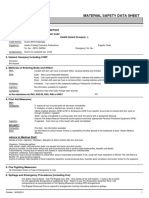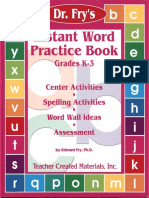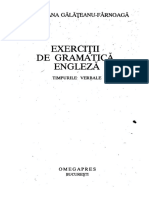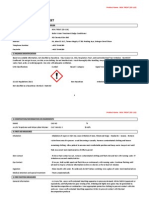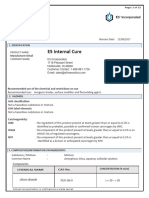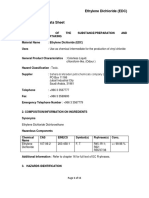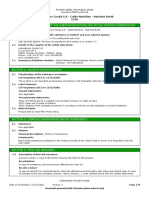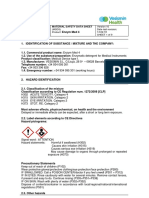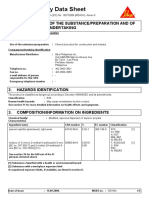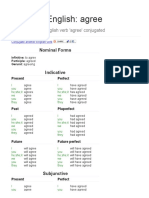Msds Iox r03 PDF
Msds Iox r03 PDF
Uploaded by
English CoachCopyright:
Available Formats
Msds Iox r03 PDF
Msds Iox r03 PDF
Uploaded by
English CoachOriginal Title
Copyright
Available Formats
Share this document
Did you find this document useful?
Is this content inappropriate?
Copyright:
Available Formats
Msds Iox r03 PDF
Msds Iox r03 PDF
Uploaded by
English CoachCopyright:
Available Formats
Conforms to Regulation (EC) No.
1907/2006 (REACH), Annex II - Europe
SAFETY DATA SHEET
IOX R 03
05915457
1. IDENTIFICATION OF THE SUBSTANCE/MIXTURE AND
OF THE COMPANY/UNDERTAKING
Identification of the substance or mixture
Product name : IOX R 03
Use of the substance/mixture : Colorants (pigments and dyestuffs), inorganic
Supplier/Manufacturer : LANXESS Deutschland GmbH, Industrial & Environmental Affairs
51369 Leverkusen, Germany, Telephone: +49 214 30 65109
E-mail: infosds@lanxess.com
Emergency telephone number : +49 214 30 99300 (Sicherheitszentrale CHEMPARK Leverkusen)
2. HAZARDS IDENTIFICATION
The product is not classified as dangerous according to Directive 1999/45/EC and its amendments.
Classification : Not classified.
See section 11 for more detailed information on health effects and symptoms.
3. COMPOSITION/INFORMATION ON INGREDIENTS
Product definition (REACH) : Mono-constituent substance
Fe2O3
Within the present knowledge of the supplier, this product does not contain any hazardous
ingredients in quantities requiring reporting in this section, in accordance with EU or national
regulations.
Yes.
4. FIRST AID MEASURES
First-aid measures
Inhalation : Move exposed person to fresh air. Keep person warm and at rest.
If not breathing, if breathing is irregular or if respiratory arrest
occurs, provide artificial respiration or oxygen by trained personnel.
Get medical attention if symptoms occur. If unconscious, place in
recovery position and get medical attention immediately. Maintain
an open airway. Loosen tight clothing such as a collar, tie, belt or
waistband.
Ingestion : No special measures required.
Skin contact : No special measures required.
Eye contact : Immediately flush eyes with plenty of water, occasionally lifting the
upper and lower eyelids. Check for and remove any contact lenses.
Continue to rinse for at least 10 minutes. Get medical attention if
irritation occurs.
See section 11 for more detailed information on health effects and symptoms.
Date of issue : 2010-03-06 Page: 1/5
IOX R 03 05915457 / 1.02
5. FIRE-FIGHTING MEASURES
Extinguishing media
Suitable : In case of fire, use water spray (fog), foam, dry chemical or CO2.
Not suitable : None known.
Special exposure hazards : No specific fire or explosion hazard.
Hazardous combustion : No specific data.
products
Special protective : Fire-fighters should wear appropriate protective equipment and self-
equipment for fire-fighters contained breathing apparatus (SCBA) with a full face-piece
operated in positive pressure mode.
6. ACCIDENTAL RELEASE MEASURES
Personal precautions : No action shall be taken involving any personal risk or without
suitable training. Keep unnecessary and unprotected personnel from
entering. Provide adequate ventilation. Put on appropriate personal
protective equipment (see section 8). Hazard of slipping on spilt
product.
Environmental precautions : Avoid dispersal of spilt material and runoff and contact with soil,
waterways, drains and sewers. Inform the relevant authorities if the
product has caused environmental pollution (sewers, waterways, soil
or air).
Large spill : Move containers from spill area. Prevent entry into sewers, water
courses, basements or confined areas. Vacuum or sweep up
material and place in a designated, labelled waste container.
Dispose of via a licensed waste disposal contractor. Note: see
section 1 for emergency contact information and section 13 for waste
disposal.
Small spill : Move containers from spill area. Vacuum or sweep up material and
place in a designated, labelled waste container. Dispose of via a
licensed waste disposal contractor.
7. HANDLING AND STORAGE
Handling : No special measures required.
Storage : No special measures required.
Packaging materials
Recommended : Use original container.
8. EXPOSURE CONTROLS/PERSONAL PROTECTION
Exposure limit values : Not available.
Recommended monitoring : If this product contains ingredients with exposure limits, personal,
procedures workplace atmosphere or biological monitoring may be required to
determine the effectiveness of the ventilation or other control
measures and/or the necessity to use respiratory protective
equipment. Reference should be made to European Standard EN
689 for methods for the assessment of exposure by inhalation to
chemical agents and national guidance documents for methods for
the determination of hazardous substances.
Date of issue : 2010-03-06 Page: 2/5
IOX R 03 05915457 / 1.02
Risk management measures
Occupational exposure controls
Technical measures : No special ventilation requirements. Good general ventilation
should be sufficient to control worker exposure to airborne
contaminants.
Personal protection measures
Respiratory protection : Recommended: Dust-protection mask
Hand protection : Recommended: gloves
Eye protection : Safety eyewear complying with an approved standard should be
used when a risk assessment indicates this is necessary to avoid
exposure to liquid splashes, mists, gases or dusts.
Recommended: safety glasses with side-shields
Skin protection : Personal protective equipment for the body should be selected
based on the task being performed and the risks involved and
should be approved by a specialist before handling this product.
Hygiene measures : Wash hands, forearms and face thoroughly after handling chemical
products, before eating, smoking and using the lavatory and at the
end of the working period. Appropriate techniques should be used
to remove potentially contaminated clothing. Wash contaminated
clothing before reusing. Ensure that eyewash stations and safety
showers are close to the workstation location.
Environmental exposure controls
Technical measures : Emissions from ventilation or work process equipment should be
checked to ensure they comply with the requirements of
environmental protection legislation. In some cases, fume
scrubbers, filters or engineering modifications to the process
equipment will be necessary to reduce emissions to acceptable
levels.
9. PHYSICAL AND CHEMICAL PROPERTIES
General information
Appearance
Physical state : Solid. [powders]
Colour : Red.
Odour : Odourless.
Important health, safety and environmental information
pH : 4 to 8 [Conc. (% w/w): 5%]
Melting point : >1000°C (>1832°F)
Density : 5 kg/L (20 °C)
Solubility : Insoluble in the following materials: cold water
10. STABILITY AND REACTIVITY
Stability : The product is stable.
Possibility of hazardous : Under normal conditions of storage and use, hazardous reactions
reactions will not occur.
Hazardous decomposition : Under normal conditions of storage and use, hazardous
products decomposition products should not be produced.
Date of issue : 2010-03-06 Page: 3/5
IOX R 03 05915457 / 1.02
11. TOXICOLOGICAL INFORMATION
Acute toxicity
Product/ingredient Result Species Dose Exposure Test
name
IOX R 03 LD50 - Rat >5000 mg/kg - -
Oral
Irritation/Corrosion
Skin : Non-irritating *Test results on an analogous product
Eyes : Non-irritating *Test results on an analogous product
12. ECOLOGICAL INFORMATION
Remarks : No known significant effects or critical hazards.
Not available.
13. DISPOSAL CONSIDERATIONS
Methods of disposal : Examine possibilities for re-utilisation. Product residues and
uncleaned empty containers should be packaged, sealed, labelled,
and disposed of or recycled according to relevant national and local
regulations. Where large quantities are concerned, consult the
supplier. When uncleaned empty containers are passed on, the
recipient must be warned of any possible hazard that may be
caused by residues. For disposal within the EC, the appropriate
code according to the European Waste List (EWL) should be used.
It is among the tasks of the polluter to assign the waste to waste
codes specific to industrial sectors and processes according to the
European Waste List (EWL).
Hazardous waste : Within the present knowledge of the supplier, this product is not
regarded as hazardous waste, as defined by EU Directive
91/689/EEC.
14. TRANSPORT INFORMATION
Regulation UN Proper shipping name Class PG Label Additional
number information
ADR/RID - - - - - Not regulated.
GGVSE - - - - - Not regulated.
ADNR - - - - - Not regulated.
IMDG - - - - - Not regulated.
IATA - - - - - Not regulated.
PG: Packing group
Date of issue : 2010-03-06 Page: 4/5
IOX R 03 05915457 / 1.02
Regulation UN Proper shipping name Class PG Label Additional
number information
Not dangerous cargo.
Keep separated from foodstuffs.
15. REGULATORY INFORMATION
EU regulations
Classification and labeling have been determined according to EU Directives 67/548/EEC and
1999/45/EC (including amendments) and take into account the intended product use.
Industrial applications.
Risk phrases : This product is not classified according to EU legislation.
Additional warning phrases : Safety data sheet available for professional user on request.
Safety phrases : Not applicable.
16. OTHER INFORMATION
Full text of R-phrases :
referred to in sections 2 and
3 - Europe
History
Date of printing : 2010-03-06
Date of issue : 2010-03-06
Date of previous issue : 2008-11-17
Version : 1.02
Indicates information that has changed from previously issued version.
Notice to reader
The data given here is based on current knowledge and experience. The purpose of this Safety
Data Sheet is to describe the products in terms of their safety requirements. The above details
do not imply any guarantee concerning composition, properties or performance.
Date of issue : 2010-03-06 Page: 5/5
You might also like
- English For Everyone English Vocabulary Builde PDFDocument362 pagesEnglish For Everyone English Vocabulary Builde PDFAd Ja98% (184)
- Msds Kalton R410a 1Document9 pagesMsds Kalton R410a 1Nelson_1492No ratings yet
- SP234 Bird GuanoDocument3 pagesSP234 Bird GuanoJohn GeddesNo ratings yet
- Ent MCQDocument9 pagesEnt MCQMuhammad Bilal69% (13)
- 5250-4rtm Structural Prepreg English SdsDocument11 pages5250-4rtm Structural Prepreg English Sdsanacarol09No ratings yet
- Fry Edward Instant Word Practice Book Grades k3Document274 pagesFry Edward Instant Word Practice Book Grades k3Immigg AnationNo ratings yet
- Galateanu Farnoaga Exercitii-De-Engleza PDFDocument571 pagesGalateanu Farnoaga Exercitii-De-Engleza PDFEnglish Coach100% (4)
- Sigmarine 48 Green 4199Document11 pagesSigmarine 48 Green 4199vikram singhNo ratings yet
- MSDS Sodium Hydrosulfite 90% Ex GuangdiDocument7 pagesMSDS Sodium Hydrosulfite 90% Ex GuangdidianNo ratings yet
- Tampa Tex 1 KG TPX 980 - WORLD - EN - 7 - REP870987Document13 pagesTampa Tex 1 KG TPX 980 - WORLD - EN - 7 - REP870987Nisma NilamsariNo ratings yet
- TurpentineDocument6 pagesTurpentineNajma Qolby JuharsyahNo ratings yet
- VISION - Safety Data Sheet (SDS) - 2021 ENGDocument3 pagesVISION - Safety Data Sheet (SDS) - 2021 ENGSophie TranNo ratings yet
- Acetone MSDSDocument8 pagesAcetone MSDSSiti MusabikhaNo ratings yet
- RC-123 GHS MSDS PDFDocument2 pagesRC-123 GHS MSDS PDFMyo SeinNo ratings yet
- WR Drakalube PDFDocument9 pagesWR Drakalube PDFCristian Orosco ValverdeNo ratings yet
- MSDS Mita Emery Oil 6007509Document7 pagesMSDS Mita Emery Oil 6007509jesuscasasNo ratings yet
- MSDS SD 118Document8 pagesMSDS SD 118Gx Navin0% (1)
- Safety Data Sheet Quorum Red Ii: Section 1. Product and Company IdentificationDocument11 pagesSafety Data Sheet Quorum Red Ii: Section 1. Product and Company IdentificationMauricio Camarena100% (1)
- SL 1301 Eco FLZ 20Document8 pagesSL 1301 Eco FLZ 20alinus4yNo ratings yet
- Fire Blanker MSDSDocument3 pagesFire Blanker MSDSShaikhRizwanNo ratings yet
- Chemicals Zetag MSDS LDP Zetag 7875 FS 40 - 0610Document7 pagesChemicals Zetag MSDS LDP Zetag 7875 FS 40 - 0610PromagEnviro.comNo ratings yet
- Akzonobel ETHOMEEN C 25Document8 pagesAkzonobel ETHOMEEN C 25Hitendra Nath BarmmaNo ratings yet
- DMDS Data SheetDocument7 pagesDMDS Data Sheetfarooq798100% (1)
- MSDS 88НDocument17 pagesMSDS 88НhgfhfNo ratings yet
- Atlanta Marine D 3005Document11 pagesAtlanta Marine D 3005vangeliskyriakos8998No ratings yet
- Library Lion Story Hour Kit PDFDocument4 pagesLibrary Lion Story Hour Kit PDFEnglish Coach50% (2)
- Module 2 - Classic Theories of Economic Growth and Development PPT - PDF - 2Document44 pagesModule 2 - Classic Theories of Economic Growth and Development PPT - PDF - 2Alyssa Alejandro50% (2)
- Textbook PDFDocument258 pagesTextbook PDFDavid ZhaoNo ratings yet
- Renault Kerax 440.35T Dxi 6X4 HD: WWW - Renault-Trucks - Co.ZaDocument4 pagesRenault Kerax 440.35T Dxi 6X4 HD: WWW - Renault-Trucks - Co.Zaentreprise.tgctp201560% (5)
- E5® Internal Cure SDSDocument12 pagesE5® Internal Cure SDSnaval malpaniNo ratings yet
- SDS - Fenomastic Emulsion Silk - English (Uk) - Dubai PDFDocument5 pagesSDS - Fenomastic Emulsion Silk - English (Uk) - Dubai PDFB50% (2)
- Lewatit Monoplus S 108 HDocument9 pagesLewatit Monoplus S 108 HlailiNo ratings yet
- Material Safety Data Sheet: Section 1. Chemical Product and Company IdentificationDocument8 pagesMaterial Safety Data Sheet: Section 1. Chemical Product and Company Identificationgplese0No ratings yet
- Maxtreat 6910 - MSDSDocument3 pagesMaxtreat 6910 - MSDSLu CianusNo ratings yet
- Msds Moisturiser PlusDocument3 pagesMsds Moisturiser Pluskirsty422No ratings yet
- Nitrogen MsdsDocument2 pagesNitrogen MsdsGangsar LukmanjayaNo ratings yet
- MSDS VirukillDocument7 pagesMSDS VirukillSadhana Sentosa67% (3)
- Drako Fluid SF 10 enDocument11 pagesDrako Fluid SF 10 enthanggimme.phanNo ratings yet
- Safety Data Sheet Miraglo: Identification of The Product and CompanyDocument4 pagesSafety Data Sheet Miraglo: Identification of The Product and Companybagos deweNo ratings yet
- Ethylene Dichloride (EDC) PDFDocument11 pagesEthylene Dichloride (EDC) PDFsameng100% (1)
- 90% Hedp MSDSDocument4 pages90% Hedp MSDSanaazizNo ratings yet
- Mirr Alma Super Api SL Sae 15W40 SDSDocument8 pagesMirr Alma Super Api SL Sae 15W40 SDSAbdul GhafoorNo ratings yet
- Halothane Vet Sds - Feb 2018Document4 pagesHalothane Vet Sds - Feb 2018Hasnin ArifianiNo ratings yet
- V-Clean 66 SDSDocument11 pagesV-Clean 66 SDSIkhwanHasbullahNo ratings yet
- Caldo Nutritivo - CondaDocument9 pagesCaldo Nutritivo - CondaLiseth VargasNo ratings yet
- Ammonium OxalateDocument5 pagesAmmonium Oxalatedhanaraj39No ratings yet
- Safety Data Sheet: Durasurf Ds-3220ClDocument5 pagesSafety Data Sheet: Durasurf Ds-3220CleadriesNo ratings yet
- Material Safety Data SheetDocument5 pagesMaterial Safety Data SheetTeguh SilaNo ratings yet
- MSDS Linalool PDFDocument7 pagesMSDS Linalool PDFSyafira Indah JulianaNo ratings yet
- MSDS Agenda 25 ECDocument3 pagesMSDS Agenda 25 ECSadhana Sentosa100% (1)
- Enzym Med - MSDSDocument9 pagesEnzym Med - MSDSPan SoapNo ratings yet
- 306Document6 pages306vinithaNo ratings yet
- KCC Msds Cerakwool (RCF) (GHS) (Eng)Document7 pagesKCC Msds Cerakwool (RCF) (GHS) (Eng)HaniffFadzilNo ratings yet
- Genapol LA 090 MSDSDocument10 pagesGenapol LA 090 MSDSJulián David de la CruzNo ratings yet
- Chemwatch Australian MSDS 6632-96Document15 pagesChemwatch Australian MSDS 6632-96Vijo JoseNo ratings yet
- Msds Mineral Transformer OilDocument5 pagesMsds Mineral Transformer OilkhaiNo ratings yet
- Msds TriethanolamineDocument6 pagesMsds TriethanolamineAbubakar AdeniNo ratings yet
- MSDS of KT03 Lyse SolutionDocument6 pagesMSDS of KT03 Lyse Solutiondiana.kartika08No ratings yet
- R-MC MsdsDocument5 pagesR-MC MsdsSkySupplyUSANo ratings yet
- 5.2HCS-Safety Data Sheet (SDS)Document35 pages5.2HCS-Safety Data Sheet (SDS)Christian Meana100% (1)
- Pluronic L-61 EUDocument5 pagesPluronic L-61 EUvNo ratings yet
- Micro Matrix Cement RetarderDocument6 pagesMicro Matrix Cement Retarderadvantage025No ratings yet
- Ig 55 Material Safety Data SheetDocument4 pagesIg 55 Material Safety Data SheetJason BartramNo ratings yet
- Safety Data Sheet Allantoin UspDocument7 pagesSafety Data Sheet Allantoin UspNhân huỳnhNo ratings yet
- Sika RaintiteDocument5 pagesSika RaintiteJoseph Cloyd L. LamberteNo ratings yet
- Msds Emal 10gDocument6 pagesMsds Emal 10gRizal RawungNo ratings yet
- Dade Actin FS PDFDocument5 pagesDade Actin FS PDFIto SukirnaNo ratings yet
- Florgard Epu SL Part A - MSDSDocument5 pagesFlorgard Epu SL Part A - MSDSGabriel GabeNo ratings yet
- Penguin Quick Guides Computer English Penguin EnglishDocument81 pagesPenguin Quick Guides Computer English Penguin Englishleeveedad100% (1)
- Million Dollar Baby PDFDocument1 pageMillion Dollar Baby PDFEnglish Coach100% (1)
- Oct11-17 LISTA PEARSON LONGMAN - PRIN PREMS LIBREXIM - ACORD MEN PDFDocument7 pagesOct11-17 LISTA PEARSON LONGMAN - PRIN PREMS LIBREXIM - ACORD MEN PDFEnglish CoachNo ratings yet
- Make or Do PDFDocument3 pagesMake or Do PDFEnglish Coach100% (1)
- Level 2 (English Vocabulary in Use Pre-Interm & Interm)Document21 pagesLevel 2 (English Vocabulary in Use Pre-Interm & Interm)nataNo ratings yet
- Let 39 S Talk 1 PDFDocument134 pagesLet 39 S Talk 1 PDFEnglish Coach100% (2)
- Job Interview Questions - Learn English Today PDFDocument2 pagesJob Interview Questions - Learn English Today PDFEnglish CoachNo ratings yet
- English Verb 'Agree' ConjugatedDocument3 pagesEnglish Verb 'Agree' ConjugatedEnglish CoachNo ratings yet
- Tenses ReviewDocument2 pagesTenses ReviewEnglish CoachNo ratings yet
- Expressions PDFDocument3 pagesExpressions PDFEnglish CoachNo ratings yet
- How To Say Zero - English With A Twist PDFDocument2 pagesHow To Say Zero - English With A Twist PDFEnglish CoachNo ratings yet
- Business Idioms in America - Bruce StirlingDocument3 pagesBusiness Idioms in America - Bruce StirlingEnglish CoachNo ratings yet
- Answer Key Test4Document1 pageAnswer Key Test4English CoachNo ratings yet
- Answer Key Test6Document1 pageAnswer Key Test6English CoachNo ratings yet
- Answer Key Test5Document1 pageAnswer Key Test5English CoachNo ratings yet
- 15 Essential English Idioms For Sounding Like A Native - Fluent LandFluent LandDocument3 pages15 Essential English Idioms For Sounding Like A Native - Fluent LandFluent LandEnglish CoachNo ratings yet
- Test 1A: © Pearson Longman 2007Document5 pagesTest 1A: © Pearson Longman 2007English CoachNo ratings yet
- Test 3A: © Pearson Longman 2007Document5 pagesTest 3A: © Pearson Longman 2007English CoachNo ratings yet
- Answer Key Test3Document1 pageAnswer Key Test3English CoachNo ratings yet
- SPTR Technical FinalDocument56 pagesSPTR Technical FinalKhaira Racel Jay PucotNo ratings yet
- 26 Scheme For Reimbursement of Mobile Phone & Digital ServicesDocument3 pages26 Scheme For Reimbursement of Mobile Phone & Digital Servicesmurali krishnaNo ratings yet
- Sap Abap Book 01 Finals PDFDocument878 pagesSap Abap Book 01 Finals PDFgabrielNo ratings yet
- Semester - S.Y 2020-2021 - : Module No.Document3 pagesSemester - S.Y 2020-2021 - : Module No.Erwil AgbonNo ratings yet
- Unit - 2 Clocks and CalendarsDocument3 pagesUnit - 2 Clocks and CalendarsVigneshwaraNo ratings yet
- Accord Tax Ruling Entre Procter & Gamble Et Le Luxembourg - 2010Document66 pagesAccord Tax Ruling Entre Procter & Gamble Et Le Luxembourg - 2010JulieMangematinNo ratings yet
- Digital CitizenshipDocument10 pagesDigital Citizenshipapi-564465449No ratings yet
- First Conditional (Exercises) : If You Eat Too MuchDocument1 pageFirst Conditional (Exercises) : If You Eat Too MuchsophilauNo ratings yet
- Analysis of Non-Productive Time (NPT) in Drilling Operations-A Case Study of The Ghadames BasinDocument10 pagesAnalysis of Non-Productive Time (NPT) in Drilling Operations-A Case Study of The Ghadames BasinAmr TohamyNo ratings yet
- Completed Water Safety Risk Assessment ExampleDocument6 pagesCompleted Water Safety Risk Assessment ExampleArchana SoorajNo ratings yet
- Multiinstrument: With Control and Protection Device For Genset Unit TYPE SPG-120/20Document2 pagesMultiinstrument: With Control and Protection Device For Genset Unit TYPE SPG-120/20Ya ŞamNo ratings yet
- ASSIGNMENT D & F Block ElementDocument6 pagesASSIGNMENT D & F Block ElementAKVanugrahNo ratings yet
- Server LogDocument6,178 pagesServer LogRizki PrtmNo ratings yet
- Research-Tataro GroupDocument42 pagesResearch-Tataro GroupKiesha TataroNo ratings yet
- Cep Lesson Plan TemplateDocument8 pagesCep Lesson Plan Templateapi-502980552No ratings yet
- Chapter 5 Utilization of Assessment ToolsDocument5 pagesChapter 5 Utilization of Assessment ToolsChristine Ivy Serrano100% (1)
- Employment Contract TemplateDocument7 pagesEmployment Contract Templatejeannajam06No ratings yet
- Unit 2 City LifeDocument9 pagesUnit 2 City LifegiangNo ratings yet
- Short Term Courses KolkataDocument3 pagesShort Term Courses KolkatalingarajsahuNo ratings yet
- Instagram 203014Document9 pagesInstagram 203014Muhammad Alamsyah IskandarNo ratings yet
- Measurement Systems Analysis: Total Quality ManagementDocument17 pagesMeasurement Systems Analysis: Total Quality Managementtlatuani1000No ratings yet
- Fundamentals of Corporate Finance: Prepared by (M.Zahid Khan)Document34 pagesFundamentals of Corporate Finance: Prepared by (M.Zahid Khan)Syed Maaz HasanNo ratings yet
- Piping Length RevDocument2 pagesPiping Length RevMing Ren TeyNo ratings yet
- Bond With Pidilite SubmissionDocument3 pagesBond With Pidilite SubmissionNainesh SorathiyaNo ratings yet
- Rizzi, Locality and Left PeripheryDocument27 pagesRizzi, Locality and Left PeripheryWalter OruéNo ratings yet
- NERO116 Neuroanatomy Atlas Fall 2022 6Document4 pagesNERO116 Neuroanatomy Atlas Fall 2022 6NigelNo ratings yet


